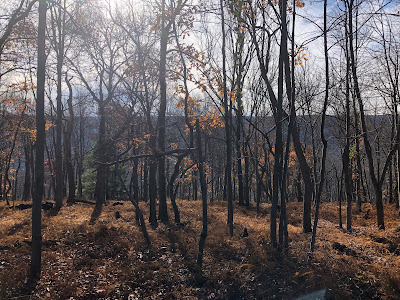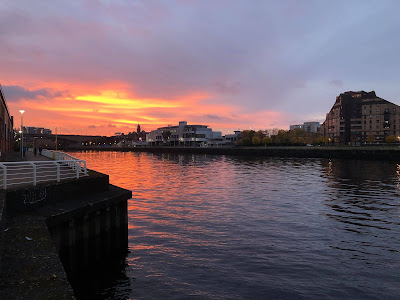 |
| A view from Chestnut Ridge looking out towards the Kittatinny Ridge |
I have been thinking about change a lot lately. Perhaps it is because I work in the areas of climate change and restoration. Or because we have seen so many changes resulting from Covid-19 and the deep partisan divides in this country. There has also been a lot of change on the campus where I work in terms of programmatic offerings, structure, personnel, and leadership. In fact, our institutional mission notes that each of us must be prepared for “transformative leadership in a world of change.” Maybe I am simply growing older and am reaching the contemplative phase of my life.
Virginia Woolf once wrote “A self that goes on changing is a self that goes on living.” I recently wrote to colleagues saying that change is inevitable and essential for institutional and personal resilience.
I live in a tiny rural community where change is not always obvious or at least seems to come at a slower pace. We have escaped (so far) the rapid development of warehouses and distribution centers that have taken over way too much open space in eastern Pennsylvania, covering once-fertile farmland and creating acres of impervious surface where idling tractor trailers sit and spew greenhouse gases and unhealthy particulate matter. Not a lot of new homes have been built around here, but some neighbors have moved on or passed on. There are still family-run farms where you can pick blueberries, strawberries, or apples or buy fresh eggs, a side of beef, or the best sweet corn harvested only a few hours earlier. At some, you can go and cut your own Christmas tree.
The former kids in the area now have babies of their own. Some old farmhouses are falling into disrepair, perhaps because the aging population can no longer do the work and the children have moved away. Our big old farmhouse is kind of quiet with our own sons grown and living quite far away. Perhaps someday, we won't be able to keep up with the repairs and chores either.
I see changes in the landscape. Hundreds of ash trees are dead or dying thanks to an unwelcome newcomer, the Emerald Ash Borer. The old oaks aren’t faring well either, probably due to other invasive insects, acid rain, and various diseases. Old farm fields are becoming overgrown with invasive shrubs and vines that seem to produce absurd yields of berries readily eaten by birds who are looking for habitat among the changing vegetation and are very good at seed dispersal. We see lots of ticks and annoying insects, but fewer bees, butterflies, and other pollinators.
Where a brush fire raged several years ago, we now have thick tangles of green briar complete with sharp thorns and no redeeming features that I can think of, although some say the early spring leaves are good in salads.
We went to the local firehouse breakfast this morning, perhaps for the last time. This used to be a routine first-Sunday-of-the-month tradition for our family, and for so many others. Because of Covid, these breakfasts have been scarce over the past few years. The local volunteer fire company is also short on volunteers, many long-time breakfast attendees don’t seem to be around anymore, and the younger generation has other interests. These events were always an opportunity to overhear local gossip, meet local and state politicians who were serving breakfast while campaigning, and see familiar faces – even if they were people that you didn’t know well.
Although we have lived here for over 27 years, we are still relative newcomers compared to the families with names that have been here for generations: Borger, Silfies, Smale, Frantz, Frable, Barlieb, Greenzweig, Kunkle, and more. They are all very proud of their family history.
When getting our breakfast tickets, the elderly woman serving as cashier surprised us when she asked David if he still plays music, recalling that he and our son (Corey) played together. That certainly wasn’t anytime recently! We have often lamented that we really don’t know many of the people in the community (in part because we work over “the mountain” in the big valley to the south), but as in many small “towns”, people know.
At our long table, we sat across from some long-time Kunkletownians and some relatives newer to the region than us. As we ate, we shared memories and stories of things that no longer exist like the local butcher shop where you could bring a mason jar and get it filled with authentic blackstrap molasses back in the day – along with the best cuts of meat. We lamented the pending loss of this firehouse breakfast and commented on the extra-large portions we received today. I guess they are trying to clear out the pantry. One woman, who used to serve at these monthly breakfasts, has lived in her farmhouse for over 60 years. She recalled the woman who once owned the farm that we now inhabit: Kate (Catherine) Brands – a painter, educator and lover of flowers and the view of the Kittatinny Ridge that we get to cherish daily. I smiled when I thought of first meeting Kate and our good fortune to be able to “inherit” and care for her beloved property.
Suddenly, I realized that a dear friend and colleague who paints and gardens (and writes books and teaches) has almost the same name. Brandes instead of Brands. I don't know why that never occurred to me before, but I love that connection from the past to present.
As I write this, the early setting sun of December is illuminating the treetops at the eastern edge of our invasive-shrub-invested field, and I have a clear long view of the Kittatinny Ridge, known locally as Blue Mountain” (or “Endless Mountain” by the native people that once inhabited the region). My multi-talented friend Kate, a geologist by training, would likely tell me that this ridge forms the southern and eastern edge of the Ridge-and-Valley Appalachians in Pennsylvania and has undergone dramatic changes over eons, a hard-to-grasp geological timescale of millions of years rather than a few human generations. It is even harder to fathom that the Appalachians were once likely as high as the Himalayans!
For now, I am content with the realization that I am blessed to own this little piece of farmland and old home in a quiet rural community with a long history, rich stories, and good people. But I will miss those firehouse breakfasts.
 |
| Shadow Mountain Farm |



































